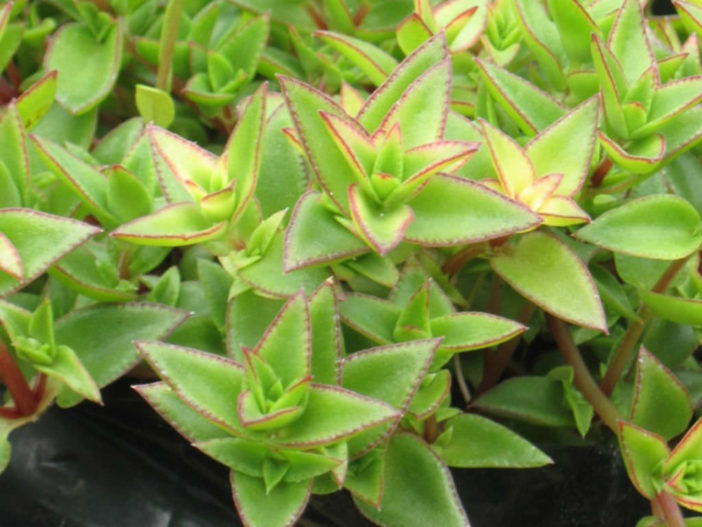Scientific Name
Crassula pellucida subsp. brachypetala (Drege ex Harv.) Tölken
Synonym(s)
Crassula brachypetala, Crassula prostrata, Sedum brachypetalum
Scientific Classification
Family: Crassulaceae
Subfamily: Crassuloideae
Genus: Crassula
Origin
Crassula pellucida subsp. brachypetala is native to South Africa (North West, Gauteng, Mpumalanga, Free State, KwaZulu-Natal, Eastern Cape) and Eswatini (formerly Swaziland). It grows in grassland, often in moist areas in forest margins or on rock outcrops.
Description
Crassula pellucida subsp. brachypetala is a much-branched succulent with slender branches with hairy internodes and fleshy, glabrous to rarely hairy leaves tapering to a sharp point. The stems grow to 2 feet (60 cm) long, lying along the ground with tips turned upwards. Leaves are green with irregularly fringed, usually red margins. They vary from narrow to broader than long, up to 1 inch (2.5 cm) long and 0.5 inches (1.2 cm) wide, with or without a petiole.
The flowers are star-shaped, 5-merous, white, often tinged pink, and appear in terminal clusters, usually in summer and sporadically at other times of the year.

Hardiness
USDA hardiness zones 9b to 11b: from 25 °F (−3.9 °C) to 50 °F (+10 °C).
How to Grow and Care
Crassulas are easy to grow, but they are susceptible to mealy bugs and fungal diseases. As with all succulents, overwatering is sure to be fatal, so err on the side of too dry rather than too wet. Never let your plant sit in water. If you water from beneath by letting the plant sit in a saucer of water, make sure to pour off any excess water after a few minutes.
These succulents are generally started by division, offsets, or leaf cuttings. Crassulas can be easily propagated from a single leaf. Sprout leaves by placing them into a potting mix for succulents, then cover the dish until they sprout.
Repot as needed, preferably during the warm season. To repot your Crassula, ensure the soil is dry before repotting, then gently remove the pot. Knock away the old soil from the roots, making sure to remove any rotted or dead roots in the process. Treat any cuts with a fungicide. Place the plant in its new pot and backfill it with potting soil, spreading the roots as you repot. Leave the plant dry for a week or so, then begin to water lightly to reduce the risk of root rot.
Learn more at How to Grow and Care for Crassula.
Links
- Back to genus Crassula
- Succupedia: Browse succulents by Scientific Name, Common Name, Genus, Family, USDA Hardiness Zone, Origin, or cacti by Genus
Photo Gallery
Click on a photo to see a larger version.



